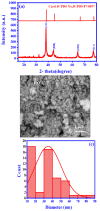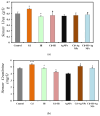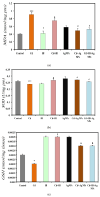Therapeutic Efficacy of Helianthemum lippii Extract and Silver Nanoparticles Synthesized from the Extract against Cadmium-Induced Renal Nephrotoxicity in Wistar Rats
- PMID: 39204087
- PMCID: PMC11357364
- DOI: 10.3390/ph17080982
Therapeutic Efficacy of Helianthemum lippii Extract and Silver Nanoparticles Synthesized from the Extract against Cadmium-Induced Renal Nephrotoxicity in Wistar Rats
Abstract
This study explored the therapeutic efficacy of Helianthemum lippii and silver nanoparticles (Ag NPs) synthesized using a H. lippii extract to alleviate cadmium-induced nephrotoxicity in Wistar rats. Sub-acute toxicity assessments of H. lippii (100 mg/kg, 1000 mg/kg, and 4000 mg/kg) and Ag NPs (2 mg/kg and 10 mg/kg) did not find any significant difference, compared with untreated control rats (n = 3 animals/group). Then, the adult Wistar rats were divided into one control (untreated/unexposed) and six experimental groups (n = 5/group): Ag NPs alone, H. lippii alone, exposure to 50 mg/kg CdCl2 in drinking water for 35 days, exposure to CdCl2 for 35 days followed by treatment with 0.1 mg/kg/day Ag NPs (intraperitoneal injection) and/or 100 mg/kg/day H. lippii by gavage for 15 days. In the CdCl2-exposed group, body weight decreased; urea, creatinine, and uric acid concentrations increased (p < 0.05 vs. control), indicative of nephrotoxicity, antioxidant defenses (SOD, GSH, and CAT) were reduced, and malondialdehyde concentration increased. Moreover, the kidney's architecture in CdCl2-exposed rats was altered: fibrosis, inflammatory cell infiltration, glomerular destruction, and tubular dilatation. Treatment with H. lippii and/or Ag NPs after CdCl2 exposure improved some of the renal function and architecture alterations induced by CdCl2, and also increased body weight. This study underscores the potential therapeutic applications of H. lippii and Ag NPs to decrease oxidative stress and promote xenobiotic detoxification, in line with the growing emphasis on environmentally conscious practices in scientific research and healthcare.
Keywords: Helianthemum lippii; Wistar rats; biochemical parameters; cadmium toxicity; gavage; histopathology; intraperitoneal injection; nephrotoxicity; oxidative stress; silver nanoparticles.
Conflict of interest statement
The authors declare that the research was conducted in the absence of any commercial or financial relationships that could be construed as a potential conflict of interest. The author(s) declared that they were an editorial board member of Frontiers at the time of submission.
Figures










Similar articles
-
Antimutagenic and anticoagulant therapeutic effects of Ag/Ag2O nanoparticles from Olea europaea leaf extract: mitigating metribuzin-induced hepato-and nephrotoxicity.Front Pharmacol. 2024 Oct 23;15:1485525. doi: 10.3389/fphar.2024.1485525. eCollection 2024. Front Pharmacol. 2024. PMID: 39508051 Free PMC article.
-
Phytochemical profiling and fractionation of Helianthemum lippii extract versus silver nanoparticle-modified extract: assessment of photoprotective, anti-hemolytic, antibacterial, and anti-inflammatory properties.Front Chem. 2024 Dec 10;12:1508707. doi: 10.3389/fchem.2024.1508707. eCollection 2024. Front Chem. 2024. PMID: 39720555 Free PMC article.
-
Therapeutic potential of silver nanoparticles from Helianthemum lippii extract for mitigating cadmium-induced hepatotoxicity: liver function parameters, oxidative stress, and histopathology in wistar rats.Front Bioeng Biotechnol. 2024 Jun 27;12:1400542. doi: 10.3389/fbioe.2024.1400542. eCollection 2024. Front Bioeng Biotechnol. 2024. PMID: 39007052 Free PMC article.
-
Characterization of ethyl acetate and n-butanol extracts of Cymbopogon schoenanthus and Helianthemum lippii and their effect on the smooth muscle of the rat distal colon.J Ethnopharmacol. 2020 Apr 24;252:112613. doi: 10.1016/j.jep.2020.112613. Epub 2020 Jan 23. J Ethnopharmacol. 2020. PMID: 31981748
-
Nephroprotective and anti-inflammatory potential of aqueous extract from Persea americana seeds against cadmium-induced nephrotoxicity in Wistar rats.Biometals. 2021 Oct;34(5):1141-1153. doi: 10.1007/s10534-021-00333-w. Epub 2021 Aug 7. Biometals. 2021. PMID: 34365580
Cited by
-
Cadmium toxicity, health risk and its remediation using low-cost biochar adsorbents.Open Life Sci. 2025 Aug 11;20(1):20251131. doi: 10.1515/biol-2025-1131. eCollection 2025. Open Life Sci. 2025. PMID: 40822969 Free PMC article. Review.
-
Targeted therapeutic strategies for the kidney.Expert Opin Ther Targets. 2024 Nov;28(11):979-989. doi: 10.1080/14728222.2024.2421756. Epub 2024 Nov 3. Expert Opin Ther Targets. 2024. PMID: 39491501 Review.
-
Antioxidative Function of Zinc and Its Protection Against the Onset and Progression of Kidney Disease Due to Cadmium.Biomolecules. 2025 Jan 27;15(2):183. doi: 10.3390/biom15020183. Biomolecules. 2025. PMID: 40001486 Free PMC article. Review.
-
Antimutagenic and anticoagulant therapeutic effects of Ag/Ag2O nanoparticles from Olea europaea leaf extract: mitigating metribuzin-induced hepato-and nephrotoxicity.Front Pharmacol. 2024 Oct 23;15:1485525. doi: 10.3389/fphar.2024.1485525. eCollection 2024. Front Pharmacol. 2024. PMID: 39508051 Free PMC article.
-
Phytochemical profiling and fractionation of Helianthemum lippii extract versus silver nanoparticle-modified extract: assessment of photoprotective, anti-hemolytic, antibacterial, and anti-inflammatory properties.Front Chem. 2024 Dec 10;12:1508707. doi: 10.3389/fchem.2024.1508707. eCollection 2024. Front Chem. 2024. PMID: 39720555 Free PMC article.
References
-
- Monsefi M., Fereydouni B. The effects of cadmium pollution on female rat reproductive system. J. Infertil. Reprod. Biol. 2013;1:1–6. doi: 10.1007/s11356-018-2821-5. - DOI
LinkOut - more resources
Full Text Sources
Miscellaneous

